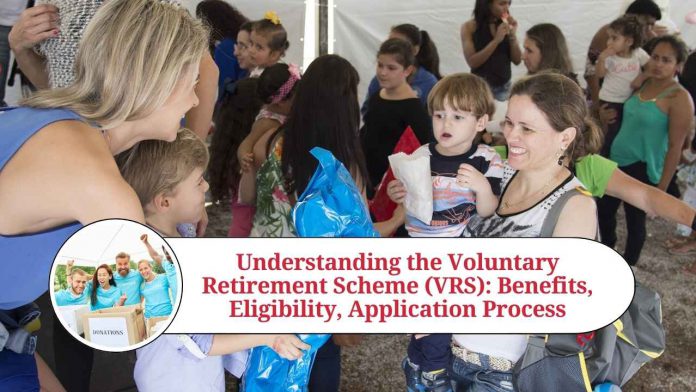Voluntary Retirement Scheme (VRS): An Overview
The Voluntary Retirement Scheme (VRS) is a program initiated by the government of India to facilitate the voluntary retirement of employees from public sector undertakings (PSUs) and other government organizations. VRS is designed to encourage the younger generation to enter the workforce and provide financial assistance to those who wish to retire early. In this blog, we will discuss the various aspects of the VRS, including its benefits, eligibility criteria, and the procedure to apply for it.
Benefits of the VRS
The VRS offers several benefits to employees who opt for it, including:
- Financial Assistance: The scheme provides a lump-sum amount to employees who opt for voluntary retirement. The amount offered depends on the employee’s length of service and the pay scale.
- Job Opportunities: The VRS creates job opportunities for younger people, as vacant positions are filled by new recruits.
- Early Retirement: The VRS allows employees to retire early, which is beneficial for those who wish to pursue other interests or hobbies.
Eligibility Criteria
To be eligible for the VRS, an employee must meet the following criteria:
- Age: The employee must be at least 40 years of age or have completed 20 years of service.
- Tenure: The employee must have completed a minimum of 10 years of service.
- Job Status: The employee must be a permanent employee of the organization.
Procedure to Apply for the VRS
The procedure to apply for the VRS is as follows:
- Application: The employee must submit an application to the employer expressing their willingness to opt for the VRS.
- Acceptance: The employer will consider the application and accept or reject it based on the eligibility criteria.
- Offer: If the application is accepted, the employer will offer a lump-sum amount to the employee as per the guidelines of the VRS.
- Acceptance: The employee must accept the offer within a specified period, failing which the offer will be considered as declined.
- Payment: Once the offer is accepted, the employer will pay the lump-sum amount to the employee within a specified period.
Advantages and Disadvantages of VRS
While the VRS provides many benefits to employees and organizations, it also has its drawbacks. Here are some of the advantages and disadvantages of the VRS:
Advantages:
- Cost Reduction: The VRS helps organizations reduce their wage bills by allowing them to replace highly paid, senior employees with younger and less expensive ones.
- Improved Efficiency: The scheme allows organizations to restructure their workforce and align it with their changing business requirements, leading to increased efficiency and productivity.
- Employee Welfare: The VRS provides financial assistance to employees who wish to retire early, ensuring their financial well-being and providing them with an opportunity to pursue other interests.
Disadvantages:
- Loss of Experience: The VRS leads to the loss of experienced employees, which can affect the organization’s productivity and efficiency in the short term.
- Morale: The VRS can affect the morale of remaining employees, who may feel that the organization does not value their contribution.
- Legal Issues: Organizations must comply with the guidelines and regulations of the VRS, and any non-compliance can lead to legal issues.
Conclusion
In conclusion, the VRS is a well-intentioned scheme designed to benefit both employees and organizations. It provides financial assistance to employees who wish to retire early, creates job opportunities for the younger generation, and helps organizations restructure their workforce. However, it is essential to carefully consider the advantages and disadvantages of the scheme before making a decision. Organizations must ensure that they comply with the guidelines and regulations of the VRS, and employees must consider the long-term impact of their decision to opt for the scheme.
Read more useful content:
Frequently Asked Questions (FAQs)
- What is the Voluntary Retirement Scheme (VRS)?
The Voluntary Retirement Scheme (VRS) is a program initiated by the government of India to facilitate the voluntary retirement of employees from public sector undertakings (PSUs) and other government organizations.
- Who is eligible for the VRS?
To be eligible for the VRS, an employee must be at least 40 years of age or have completed 20 years of service, have completed a minimum of 10 years of service, and be a permanent employee of the organization.
- What benefits does the VRS offer?
The VRS offers financial assistance to employees who opt for voluntary retirement. The amount offered depends on the employee’s length of service and pay scale. The scheme also creates job opportunities for the younger generation and allows employees to retire early.
- How can an employee apply for the VRS?
The employee must submit an application to the employer expressing their willingness to opt for the VRS. The employer will then consider the application and accept or reject it based on the eligibility criteria.
- What happens if an employee’s application for VRS is accepted?
If the application is accepted, the employer will offer a lump-sum amount to the employee as per the guidelines of the VRS. The employee must accept the offer within a specified period, failing which the offer will be considered as declined.
- What is the lump-sum amount offered under the VRS?
The lump-sum amount offered under the VRS depends on the employee’s length of service and pay scale.
- Can an employee opt for the VRS if they are not eligible?
No, an employee cannot opt for the VRS if they do not meet the eligibility criteria.
- Is the VRS compulsory for employees?
No, the VRS is voluntary, and employees can choose to opt for it if they wish to retire early.
- Can an employee withdraw their application for the VRS?
Yes, an employee can withdraw their application for the VRS before accepting the offer.
- Is the VRS available only in India?
No, the VRS is not limited to India and is available in other countries as well. However, the guidelines and regulations may vary depending on the country.




















